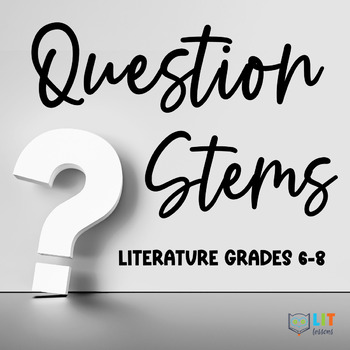Question Stems Higher Order Thinking Reading Literature Grades 6-8
- PDF
Also included in
- The higher order Question Stems resource for reading literature and informational texts is an incredible teaching tool that will help your students grow through its standards-aligned bank of questions. The 310 higher order thinking question stems are curated and organized based on level of challengePrice $6.50Original Price $8.00Save $1.50
Description
The higher order Question Stems resource for reading literature is an incredible teaching tool that will help your students grow through its standards-aligned bank of questions. The 205 higher order thinking question stems are curated and organized based on level of challenge, making it a great resource for differentiation. Rather than overwhelming with a ton of questions, the resource selectively presents the best of questions so you can ask the right one at the right moment. Its rigorous lines of questioning will prompt critical thinking, foster rich discussions, and help create meaningful tasks. The Question Stems resource is comprehensive and flexible. It can be used in the classroom, as part of a professional development, a staple of PLC, or a guide for creating your next novel study or assessments. Its uses are vast, and you will find yourself referencing this valuable resource again and again.
Question Stems Higher Order Thinking Reading Literature Grades 6-8 - Snapshot of Resources:
- 205 Question Stems
- Resource Key
- Implementation Notes
- Posters
Question Stems – Suggestions for Implementation: These suggestions explain the variety of uses of the Question Stems resource. Differentiation, lesson and unit planning, team-teaching, and student-led choice all are options. From in-class activities to professional learning sessions, the resource’s flexibility allows for multiple uses that best suits your school context.
Question Stems – Resource Key: The resource key provides an overview of the materials provided, including a description of the four levels of questioning, key verbs for each level, and an example of each questioning level. Based on Bloom’s Taxonomy and Depth-of-Knowledge questioning, the key breaks down these levels of challenge in an easy-to-understand way that will help you better facilitate rigorous and meaningful questions in the ELA classroom.
Question Stems – Literary Elements: The question stems provided cover a variety of literary elements including: character (19), plot (15), setting (15), conflict (17), figurative language (17), flashback (20), symbolism (16), theme (17), point of view (19), suspense (12), tone and mood (16), author’s purpose (13), and main idea (9). With questions for so many literary elements, you can rest assured that you have the materials that cover the essential Common Core ELA standards necessary for student success. Within the questions, [brackets] serve as placeholders that will make it easy to include details specific to your text or goals.
Question Stems – Posters: The Question Stems posters provide an additional way to access, display, and use these resources. You can print them out for students, create posters to hang in the classroom, or even display them for a professional development session. They are an additional tool for you to use to meet the needs of your professional and classroom needs.
Finally, these resources are EDITABLE to help you create materials for your students. Simply copy and paste the question stem, modify it for your in-class text, and watch your students become more adept in their literary analysis skills.






